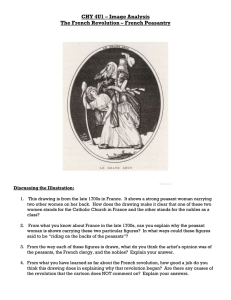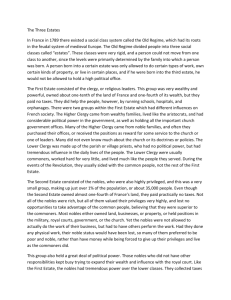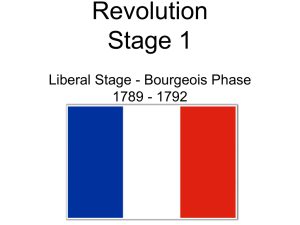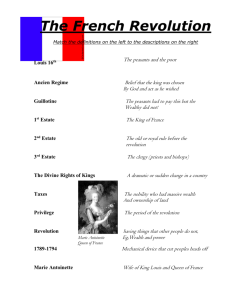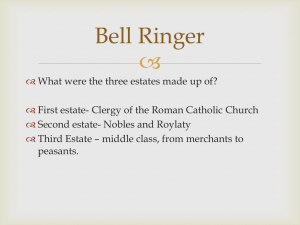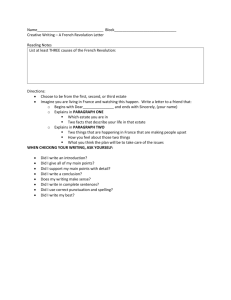Modern European History Name: ___________________ Date: ____________
advertisement
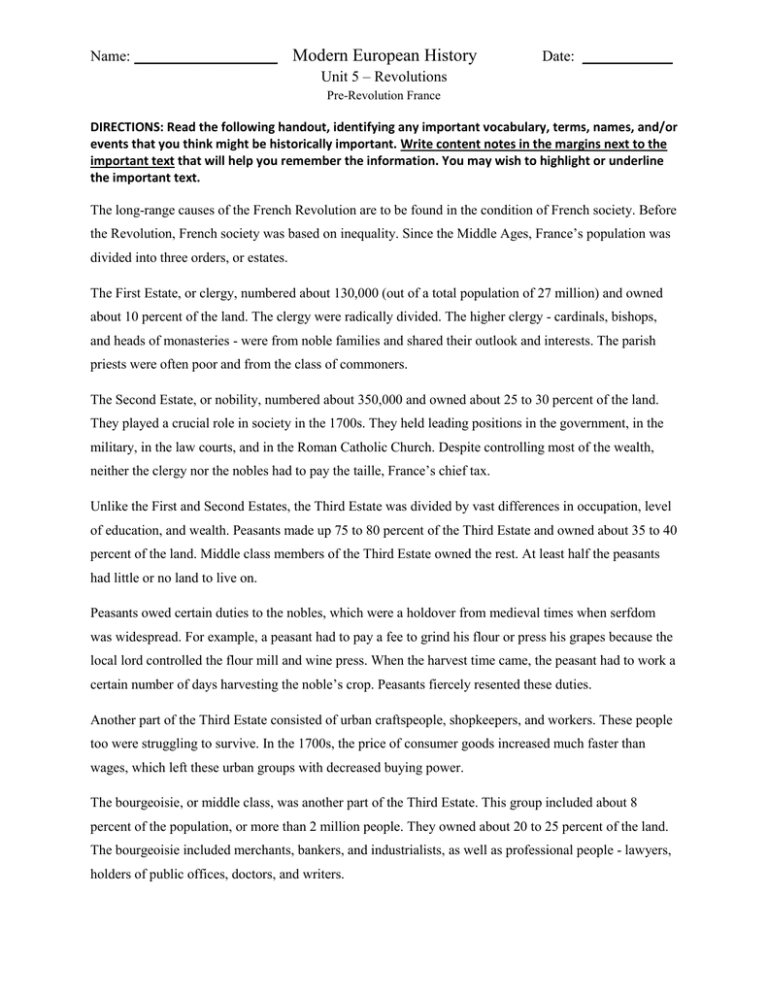
Name: ___________________ Modern European History Date: ____________ Unit 5 – Revolutions Pre-Revolution France DIRECTIONS: Read the following handout, identifying any important vocabulary, terms, names, and/or events that you think might be historically important. Write content notes in the margins next to the important text that will help you remember the information. You may wish to highlight or underline the important text. The long-range causes of the French Revolution are to be found in the condition of French society. Before the Revolution, French society was based on inequality. Since the Middle Ages, France’s population was divided into three orders, or estates. The First Estate, or clergy, numbered about 130,000 (out of a total population of 27 million) and owned about 10 percent of the land. The clergy were radically divided. The higher clergy - cardinals, bishops, and heads of monasteries - were from noble families and shared their outlook and interests. The parish priests were often poor and from the class of commoners. The Second Estate, or nobility, numbered about 350,000 and owned about 25 to 30 percent of the land. They played a crucial role in society in the 1700s. They held leading positions in the government, in the military, in the law courts, and in the Roman Catholic Church. Despite controlling most of the wealth, neither the clergy nor the nobles had to pay the taille, France’s chief tax. Unlike the First and Second Estates, the Third Estate was divided by vast differences in occupation, level of education, and wealth. Peasants made up 75 to 80 percent of the Third Estate and owned about 35 to 40 percent of the land. Middle class members of the Third Estate owned the rest. At least half the peasants had little or no land to live on. Peasants owed certain duties to the nobles, which were a holdover from medieval times when serfdom was widespread. For example, a peasant had to pay a fee to grind his flour or press his grapes because the local lord controlled the flour mill and wine press. When the harvest time came, the peasant had to work a certain number of days harvesting the noble’s crop. Peasants fiercely resented these duties. Another part of the Third Estate consisted of urban craftspeople, shopkeepers, and workers. These people too were struggling to survive. In the 1700s, the price of consumer goods increased much faster than wages, which left these urban groups with decreased buying power. The bourgeoisie, or middle class, was another part of the Third Estate. This group included about 8 percent of the population, or more than 2 million people. They owned about 20 to 25 percent of the land. The bourgeoisie included merchants, bankers, and industrialists, as well as professional people - lawyers, holders of public offices, doctors, and writers. The middle class was unhappy with the privileges held by nobles. They did not want to abolish the nobility, however, but to better their own position. Some bourgeoisie had managed to become nobles by being appointed to public offices that conferred noble status. About 6,500 new nobles had been created by appointment during the 1700s. The bourgeoisie also shared certain goals with the nobles. Both groups were increasingly upset with a monarchical system resting on privileges and on an old and rigid social order. Both were also drawn to the new political ideas of the Enlightenment. Increased criticism of the old order of society had been part of the eighteenth-century Enlightenment. The philosophes did not advocate revolution. Their ideas, however, were widely spread among the literate middle class and noble elites of France. When the revolution began, revolutionary leaders often quoted Enlightenment writers, especially Rousseau. Social conditions and Enlightenment ideas, then, formed an underlying background to the French Revolution. The immediate cause of the revolution was the near collapse of the French budget. Although the economy had been expanding for 50 years, there were periodic crises. Bad harvests in 1787 and 1788 and a slowdown in manufacturing led to food shortages, rising prices for food, and unemployment. On the eve of the revolution, the French economy was in crisis. Despite these problems, the French king and his ministers continued to spend enormous sums of money on wars and court luxuries. The queen, Marie Antoinette, was especially known for her extravagance and this too caused popular resentment. When the government decided to spend huge sums to help the American colonists against Britain, the budget went into total crisis. With France on the verge of financial collapse by 1789, Louis XVI was forced to call a meeting of the Estates-General. This was the French parliament, and it had not met since 1614. 2

